#arkham horror 2e
Text
Re-Animator/Arkham Horror Custom Game Content: The Investigators
I don't have a title for this project yet, but it's basically its own expansion pack at this point. If anybody has any ideas for a rad name, lemme know!
These cards have only been playtested in a non-representative game; I will probably try to playtest them again tonight!

Card info reads as follows:
Francesca Danelli
the Journalist
4 Sanity
6 Stamina
Home: Newspaper
Fixed Possessions: $7, 1 Clue Token, 1 Special (Retainer)
Random Possessions: 2 Common Items, 1 Spell, 1 Skill
SPECIAL: She is a Wartime Journalist. Any phase: Francesca gains +1 to combat rolls when wielding guns. She gains 1 extra Clue token from all in-game events or items, excluding Clues collected from unstable Locations.
Focus: 2
SPEED: 0 1 2 3
SNEAK: 5 4 3 2
FIGHT: 1 2 3 4
WILL: 3 2 1 0
LORE: 2 3 4 5
LUCK: 4 3 2 1
Creator Comments: The hardest part was, let's be real, trying to make Francesca into a character who isn't defined entirely as "one leg in the really toxic love triangle between her, Dan and Herbert". It's a shame that "Bride" never gave her space to be somebody. Being an international journalist who is habitually embedded in war zones in the late 1980s is truly rich soil for a character to grow in.
Francesca is slow because she's unfamiliar with Arkham's layout; this gives her a higher Sneak so she can escape monsters if need be. Her low Will and low-ish Sanity mean she may well break from the horror of seeing monsters before she gets a chance to fight them, but everybody's gotta have weaknesses. She has mid-grade Luck to help her cope with random encounters.
Her high Lore is partly to justify giving her a Spell, but mostly because "Lore" as a stat relates to how well an investigator correctly understands and copes with the Mythos as they encounter it in-game. And, well. Francesca had Herbert's number from frame one, didn't she? She could've gotten an award for Most Correct Character In "Bride" On Literally Every Call She Made, if she hadn't decided that Dan was Dudley Do-Right.
#reanimator#re animator 1985#bride of reanimator#bride of reanimator 1991#bride of re animator#reanimator 1985#fandom project#crossover event#arkham horror#arkham horror 2e#custom investigator#board games#tabletop games#board game design
21 notes
·
View notes
Text
Reading through Mask of the Mythos for Scion 2e (Which is. dumb because I'm not running Scion anytime soon sadly) and I know they were just trying to portray that Arkham in (Current year) just looks like any other mid sized town on the outside, but the specific mention of a boba tea place fucking sent me, its just so out of place with. Y'know. all the eldritch horror. why did that have to be mentioned, you fucking yassified the Miskatonic valley
#Scion 2e#new system I don't talk about before jumpscare#it looks fun but. currently rotating between two ongoing campaigns#one in Pathfinder and one is a mixed splat CofD game because I hate myself#and in the background I'm cooking up a Hengeyokai chronicle and looking into Lancer#I shouldn't be allowed to add a fifth thing to the pile#right? please stop me this post is a cry for help
5 notes
·
View notes
Text
The Far Realms vs. Obyriths: Cosmic Horror in D&D
Shout-out, once again, to Afroakuma, from whom I learned most of the material I’m about to explain and with whom I’ve had many fascinating discussions about this topic.
It’s ya boi Vox, back at it to complain about RPG shit in an educational fashion again. Remember when I did a whole article about (evil) gods in D&D, arguing that they have more potential than to be used like supervillains? We’re gonna do that again, but this time with incorporating cosmic horror elements into your D&D campaign. Some of this advice may also be useful for games similar to D&D but for the sake of my own sanity I’m gonna confine myself to the one system or I’m gonna be here until my kids are in college.
This article will be broken down into three parts: an overview of cosmic horror’s origin and original thesis (in which we travel my favorite magical land, Full And Complete Context), a breakdown of the Far Realms in D&D (including older takes from late 2e & 3.5, how those changed in 4e, and their ambiguous state in 5e) & how you might use them for a cosmic horror campaign, and a breakdown of Obyriths in D&D and how you might use them in your campaign.
No discussion of cosmic horror is complete without some Content Warnings. Right up front: cosmic horror has its roots in extremely racist fiction, and I’m going to be talking about that straight-up. Also included in this article will be body horror, descriptions of mind control and mental corruption, supernaturally-induced madness, violence, and medical horror, among other things. This is a genre that hit the ‘fuck shit up’ button with its face on fuckin’ Zero Day and does that but again every time we successfully write something in it. Additionally, spoilers for some of Lovecraft’s work will be in here, with absolutely no tags and no warnings before they happen. You have been warned; do as thou wilt.
HP Does A Racism - Origins Of Cosmic Horror
Yeah, I’m about to be like that about it.
In the beginning there was Howard Phillips Lovecraft, an absolute garbage fire of a human being whose personal issues are such a knotted mess that I’m half-sure that the concept of the Ouroboros is just the echo of his bullshit reaching backwards through time. Like many authors of his time, Howie Love here was born into significant wealth, and while his education would be cut short (he had some manner of health problem in high school that ended his attempts at schooling) it was pretty high-quality, as it tends to be when you’re rich and white in the late 1800s. When he began writing his most famous body of work, Lovecraft had three attributes which would shape it: EXTREME racism, an incredible love for the works of Edgar Allen Poe, and every fucking phobia ever turned loose on God’s green Earth.
If you want to know more about that first point, try looking up what he named his cat; Lovecraft was so racist that even other racists thought he was too racist. Mother fucker was so racist that he wrote about the dangers of contaminating one’s bloodline with French-Canadians. His racism made it into all of his works in some way, shape, or form; many had themes of miscegenation, plenty included people of color only as deranged cultists of terrible powers, and as we’ll get into later in this segment the very racism that caused him to do these things also made him write the...let’s say ‘villains’ for lack of a better term, of his ongoing body of work as thinly-veiled stand-ins for white people.
No, really.
Lovecraft’s early work included a few short stories in the American Gothic style, the most famous of which is The Rats in the Walls. It’s a fairly classic story as far as those go, but Howie Love would soon abandon American Gothic for the genre he founded and defined: cosmic horror. Keep the racism and phobias in mind going forward, they’re about to become real important.
Howie Love Clowns On Himself - Themes And Thesis Of Cosmic Horror
While Dagon is generally accepted as the ‘first’ cosmic horror story, I prefer The Colour Out Of Space as the definitive example of the original thesis of cosmic horror at its most clean and clear (it’s also the work of Lovecraft’s that has aged the best; I highly suggest it if you haven’t read it yet!). In it, an alien presence - arguably but not necessarily an entity - crash-lands outside the fictional town of Arkham. Our narrator, a surveyor, coldly investigates the horrors that occur after and learns the sorry tale of a family destroyed by this alien presence as it blights their land, corrupts their bodies, and drives them to madness. The presence leaves, but not wholly; a fragment of itself remains behind, alongside the chilling possibility of a repeat performance.
The Colour Out Of Space, and indeed most of Howie Love’s work, was written at a time in the United States and the United Kingdom where human exceptionalism was the norm. Humans were not merely important, but special, chosen, exalted in nature and placed in a universe whose sole purpose was to be the stage for our domination. The Colour Out Of Space proposed a different idea: that we ain’t shit. Not only is humanity not exalted, but humanity is insignificant, existing at the mercy of fate, able to be casually annihilated at any time by forces we do not understand. It was a shocking proposal when it was published, and though the zeitgeist that gave it power has faded (most people realize we ain’t shit these days, can’t imagine how that fucking happened) it still resonates with many people.
The later works that defined the Cthulu Mythos would build on this theme, introducing powerful beings which claim dominion of Earth or of all reality. You’ve probably heard of most of them - Cthulu is the big one, of course, but there’s also Yog-Sothoth (The Dunwich Horror), Azazoth, Catboi Slim (Nyarthalotep), and many more, not all of which were written by Lovecraft himself. These beings are gods, or else so far above humanity that the difference is academic, and this brings us to the second defining theme of cosmic horror that Lovecraft would lay out, that of forbidden knowledge.
Protagonists in Howie Love’s stories have a tendency to lose their minds. Later authors would chalk this up to the idea that witnessing these gods or their works is so inherently horrifying that the mind simply snaps in their presence, or even that these gods are bound up in the concept of madness (this second one is a rather incompetent reading, not that I’m thinking of any PAIZO in particular that just ran with it in their RPG setting), but Howard’s own work doesn’t always bear that out. The protagonist of Call of Cthulu is not driven mad by that being - he is driven towards the brink by the realization that the Cult is still out there (and coming for his life), and that Cthulu will only rise again. Our viewpoint character in At The Mountains Of Madness realizes he has committed unspeakable atrocities on living beings much like himself by mistake, and that if further explorers come to disturb their slumber they will only repeat the same errors and lead to mankind’s annihilation. It’s not just that these ancient powers are terrifying or even that they are alien, but that to comprehend them is to understand that humans are so far beneath them that their attitude towards us cannot be thought of as ‘benevolent or ‘malevolent’, because we are beneath their notice, lesser in comparison than even a bacterium. In such a context, all humans do is consume resources better used by our superiors, and thus our existence is a profanity upon the divine. The only moral action, the stories argue, is self-annihilation; only ignorance permits us to justify our own existence to ourselves.
Sound familiar? Almost like this is the exact argument chucklefuck racists make about the existence of people of color, Jews, and anyone else they happen to not like? Yeah. This is the part where Lovecraft accidentally made himself the villain of his own work. Congratulations Howie, you played yourself. And since his audience was largely fellow white men also hard up on that whole racism thing, this idea of human profanity tapped a deep well of anxiety. I’m not about to argue that racism is over (it isn’t) and that’s why this vision of cosmic horror is less popular; indeed, it’s retained a pretty solid cult (heh) following, in part because the idea of such beings is inherently kinda terrifying. But I’d be remiss not to bring up the fact that this terror has its roots in racism, so...there you have it.
Other authors also built on the Cthulu Mythos, with Lovecraft’s enthusiastic blessing. These days their works tend to be mistakenly attributed to Howie Love himself, but that’s not actually his fault; they were published on their own, under their own authors’ names, and as far as we can tell Howard never tried to take the credit. These other authors had a tendency to substitute the indifferent divinity and corrupted humans of Lovecraft’s work with direct malice; their vision of these god-like beings was one in which they noticed humanity and did harm to it, creating a movement away from Howie Love’s original thesis (”human insignificance will lead to the unimportant and unmarked event of our destruction” & “seeking knowledge can only lead to self-annihilation”) during his life which only picked up momentum after his death. Indeed, most modern attempts at Lovecraftian horror mimic this overt malevolence, often without even lip service to the original thesis. It’s not necessarily an unworkable angle of horror, and it definitely has bones in with its origins; “God is real and He hates you personally” is a terrifying idea! But this movement away from the cold indifference of stories like The Colour Out Of Space definitely contributed to the current climate of...sloppy adaptations, let’s say.
Not that I’m thinking of any Paizo in particular.
So Should I Use Mythos Content Directly In My D&D Game Or What?
No, because I will cry and tell everyone that you punched my children and kidnapped my girlfriends.
More helpfully, probably not. The presence of other divinities, but especially evil divinities like Erythnul (Greyhawk) or Malar (Forgotten Realms) makes the thematics of cosmic horror pretty fucking weird. If you really wanted to, your best bet is to not use the published system of divinity at all (see the previously-linked article, up at the top of this one) and instead make Lovecraft’s gods the setting’s only gods. That means asking yourself some hard questions about clerics in your game world and possibly divine magic in general - that’s a separate article though - and even then you’re in for a rough row to hoe. D&D’s characters tend to be competent, dynamic, empowered - a far cry from the educated but otherwise fairly helpless protagonists on which cosmic horror tends to trade. Themes of futility in the face of incomprehensible beings don’t really make for good D&D most of the time, not when so much of the system (any edition, it doesn’t matter) is set up to create and reward cunning and heroic struggle. Classic cosmic horror, in the original proposed form, is not a good fit.
Thankfully, we have two solutions to give you what you crave in-house. Let’s start with the one that is somehow both the closer fit and the further fit.
You Have Fucked Up - The Far Realm Overview
Originally introduced in late AD&D 2e, the Far Realm as an idea hit its stride during 3.0/3.5 before getting a major rework as part of 4e’s cosmology, where it became the source of most/all aberrations. We’re gonna go ahead and pretend 4e didn’t happen, not because 4e is bad (and for the love of fuck please don’t start an edition war on my cosmic horror post) but because 4e’s cosmology just doesn’t really fit in with any of the rest. 1e <-> 3.5 is more or less coherent and you can beat 5e into line with a wrench and some harsh language, but 4e...well, anyway.
The Far Realms is outside reality. No, not in another dimension, we know what those are - those are the Planes. It’s outside reality; it is Somewhere Else. “It” is probably even the wrong term, since by definition any place (”place”) that isn’t the multiverse as D&D knows it is the Far Realm. To paraphrase Afroakuma, if the Great Wheel is a Lego brick, the Far Realm is a giant squid; if the Great Wheel is a bowl of Fruit Loops, the Far Realm is the theory that intelligences from Pluto rig the results of major sporting events. The contexts are not compatible. These two things do not go together in any way. Combining the two can only end in sorrow and woe.
So mortals try to combine the two all the time, because we’re dipshits like that.
Every now and again, some truly, monumentally stupid person - usually but not always someone inside reality - breaches the skin that contains reality inside itself, and lets in the essence of Outside. This is a phenomenally bad idea; the immediate result is corruption in both directions as the essence of each form of reality bleeds into the other. Both attempt to ‘scab’ the breach, translating the foreign substances and beings into something more like the reality they have moved to. If a breach happens, there is one of three outcomes. If you are very, very lucky, no being on the other side notices the breach, and you’ve ‘merely’ blighted and corrupted a vast stretch of land, tainting it with something sort of like, but not enough like, Chaos and Evil for millennia to come - maybe even forever. If you’re not lucky, a being on the other side notices the breach and acts to seal it, the ripple of which causes you to not have a nation or continent any more as said corruption absolutely consumes the lands in which you live. And if you are phenomenally unlucky, the being on the other side is just as stupid as you are, and it comes through. The last time that happened the original Gnomish pantheon got murdered. Their homeworld doesn’t exist any more.
There is no ‘good’ outcome. This is the repeated and absolute theme of the Far Realms; whatever your reasons for getting involved with them, whatever you wanted, whatever you were seeking, you don’t get it. Mortals fuck with the Far Realms because our inability to comprehend them leads us to think of them like things we can experience. The scabbed-over beings we meet that are from there (Psuedonatural creatures; see the Alienist prestige class in Tome & Blood and Complete Arcane, as well as the bigger version in the Epic Level Handbook) are Chaotic Evil because that is how reality translates them. They aren’t Chaos, they’re another reality, and their unwilling and unwitting corruption of all around them gets redefined as Chaotic Evil in order to reduce their damage to all of existence to a manageable fucking level. Were you seeking the Far Realms in order to harness power for great change? Get fucked, you can’t control what happens. Were you seeking magical power? Get fucked; the reason people go mad when exposed to the Far Realms isn’t just that the knowledge they gain makes no sense, it’s that the complete lack of context means all of the stuff you killed and stole and lied and cheated for is more or less completely goddamn useless. Trying to escape existence for some reason? One, death is faster, but two, hope you enjoy suffering the entire time you die - and that’s if the breach stays open long enough for you to be able to enjoy death as a concept before you get sealed away in a place where mortality doesn’t meaningfully exist.
You don’t get what you want. This was a bad idea. You fucked up.
5e, the most recent edition of D&D, mainly continues this trend. It has suggestions of the lazier interpretation of Lovecraft’s work tied to the Far Realms, which I heartily suggest you ignore, but some of the other ideas are phenomenal. The Great Old Ones Pact for Warlock has one in particular that I like quite a bit, which suggests that the Warlock-to-be created an unintended connection to a Far Realms intelligence and gained power against both of their wills and possibly without the intelligence in question even noticing. You don’t need to change a lot in 5e’s run to bring out the extant themes of the Far Realms - though admittedly this is greatly assisted by the fact that 5e barely has any Far Realms content to begin with, so there’s not a lot to edit. That also means there’s not a lot to use, so if you want to use Far Realms stuff in 5e you’re gonna have to get ready to spend a lot of time making your own. Which brings us to...
Who The Fuck Funded This Research?!? - Using The Far Realms In Your Game
Considering that all-important theme - “this was a bad idea” - the Far Realms are likely to be antagonistic in nature in your game, even if ‘antagonistic’ isn’t the right term. Published adventures have used Far Realms content as a sort of backdrop (Firestorm Peak comes to mind here) before, and you can easily make Far Realms creatures a more direct problem for your PCs by centering the campaign around a cult or research team attempting to cause a new breach. This could be a great time to engage with player-side themes such as the ethics of magic use, the cost of power, and the burden of responsibility for said power, assuming your group is down for it. Even if they’re not, horrifying monstrosities that by definition have no place in this universe are great to kick in the head(s).
What motivates people to cause a breach? Mainly stupidity, but the special kind of stupidity you only get when someone is highly educated and deeply intelligent. For awhile, in the real world, there was a burst of designers making D20 heartbreakers - successors to D&D 3.5 meant to fix its many catastrophic flaws. Each person thought they had it, the secret to make the system they both loved and hated finally function, and they were all wrong. Causing a breach into the Far Realms is like that. Every sign points to it being a bad idea. Reading the research and spells of the last people who tried it reveals that it’s a bad idea. All of the diaries and primary sources of those who did it and those who stopped them say it’s a bad idea, but that’s okay because I, Wizardhat von Dipshit, am not like those fools. I will be more careful, and the power to reshape the Planes will be mine!
The easiest way to make Far Realms creatures for use in your campaign is to start with an existing monster and fuck it up; rearrange its abilities (adding or emphasizing mental attacks and psychic damage, if you can), alter its physical form, and generally just make that shit wrong and fill its blood with spiders. If you want to get more alien from there or make something original, the best guideline I can offer for you is that aboleths were the result of Far Realms taint in the beginning of this reality (it’s telling that the closest thing reality could translate their progenitor into was a Greater Deity).
No one wants power for its own sake, of course, but what your antagonist actually wants is more or less irrelevant because the important bit is that they had every chance to know better and they’re about to make this bad decision on purpose anyway. This is how the Far Realms brings out cosmic horror themes in a heroic context; power that is beyond both mortal comprehension and control, which has no place in this reality and recoils from us as violently as we recoil from it. Like Lovecraft, whose stories revealed a deep cynicism about knowledge and science, your antagonists will be erudite individuals whose ruinous plans are only possible because of what they have learned and, in turn, chosen to ignore. If nothing is done, unstoppable catastrophe will be unleashed, and with it will come madness and desolation. If only some heroes were on hand, eh?
The disconnect the Far Realms has from classic cosmic horror is also the source of why they fit; they don’t belong here. In Lovecraft’s work, it’s humanity that doesn’t belong - we are a blight upon the rightful property of higher beings. The Far Realms are instead an intrusion, something from Elsewhere which doesn’t want to be here as much as we don’t want it here. That helps those classic cosmic horror themes work much better in this context, but maybe you’re looking for something else, something from here. Do the Planes have cosmic horror from within the shell of Reality?
Yes. Oh yes, they do.
Ancient Evil Survives - Obyrith Overview
In the beginning, there was war.
The primordial War of Law and Chaos is the greatest conflict to have ever rocked the Planes. It was so destructive, so all-encompassing, that it consumed entire Material Plane worlds, reshaped the nature of the Planes themselves, and is still happening, even now. It began in the early days of the Great Wheel and was prosecuted by Chaos, led by the self-styled Queen of Chaos, over a single question: should reality be real? Should effects follow causes, should gravity exist, should fire burn and light reveal, should things age and die, should...
The forces of Law said yes to these questions and fought to establish and maintain an order and logic to reality. Chaos fought for an unbound reality, one in which each individual would be completely free to express their own true essence as tangible changes in the existence around them. The War was never truly won or lost, but the imprisonment of Miska the Wolf-Spider broke the backs of the Chaotic coalition and brought the War to a stalemate of sorts, in a reality which, if not dominated by Law, is definitely Law-leaning. Mortals are familiar with the terrible demons used as footsoldiers by the Abyss, the Tanar’ri, who reign yet in that terrible place. But it was not the Tanar’ri in command of Chaos, and not the Tanar’ri who prosecuted that terrible War. Indeed, the beings we now recognize as demons rose up against their creators, the Obyriths, after the imprisonment of Miska. They overthrew the Obyriths in a great slaughter and replaced them as the dominant exemplars of Chaotic Evil.
The Obyriths are not dead. They plan, and they wait, and they wage war and slaughter upon their wayward slaves in the Abyss. Every last one of them burns to reignite the War and achieve their vision of unbound reality, free of the wretched Law and all too weak to survive without it.
Prisoners Of The Flesh - Obyrith Nature
So what are Obyriths? The easiest answer is that they’re demons - the first demons, in fact, which preceded the more famous Tanar’ri (when you think of demons in D&D chances are you’re thinking of a Tanar’ri), and while this answer is entirely correct it is not the whole story. Tanar’ri are famously Chaotic Evil; they revel in corruption and destruction and are driven to maliciously annihilate or taint all they come across. A demon army marching across the land will stop to personally kick every puppy between point A and point B and they will absolutely mutiny against you if you try to stop them from doing so. What is good and pure must be soiled; what exists must be made to not exist, its foundations shattered, its virtues turned against themselves, its values abandoned. Tanar’ri respect only raw might, and only as long as they think they can’t defeat it.
But Obyriths, their progenitors, are Evil Chaos.
Let’s have some examples. This little guy is a draudnu, a kind of Obyrith made from the bones of chaotic celestials which post-dates the ‘end’ of the War by a pretty significant amount of time. They’re on the weaker side for Obyriths.

(You’ll find this boi in Monster Manual V for 3.5 incidentally.)
Take a nice long look. Really take it in - because that’s not the draudnu. That’s the prison of flesh, the scab, that reality has forced on the draudnu, that the terrible Law has locked it within. The actual draudnu looks like it’s inside me God it’s inside me I can feel it growing and twisting it HURTS get it out, it’s seeping into my blood it’s inside me it’s INSIDE ME -
Let’s have another example. This is a sibriex, recently re-published in Mordenkeinan’s Tome of Foes for 5e with no mention of Obyriths, which is a damn shame. They were instrumental in defining the forms of the common breeds of Tanar’ri.

Fun, right? But again, that’s not a sibriex; the actual form of a sibriex is perfection. Absolute beauty and grace. I am nothing compared to this perfection. I am no one in the face of this perfection. My existence can only profane this perfection. I must serve the Perfect One. I must let it remake me and reshape me, I must appease it, I must make amends for the crime that is my trespass upon the reality made for the Perfect One.
Those two are ‘common’ Obyriths, examples of that race of demons which have peers who are much like themselves, but the Obyriths still have extant Demon Princes. The Queen of Chaos is still alive and nursing her ancient hate. Pale Night’s true form is so profane that reality cannot stand its existence; when she reveals it to you, the multiverse destroys your soul so that knowledge of her truth does not exist. Obox-Ob, murdered by the Queen of Chaos, yet exists as an Aspect of himself - and the Planes live in fear of the rise of the Prince of Vermin, whose truth is agony, rot, and corruption, such that even if you magically remove memory of it from your mind you continue to die from the soul outward.
And Dagon plots within the depths of his palace, sponsoring and advising Demogorgon - the Prince of Demons - and contemplating unimaginable lore of evil. The Demon Prince of Depths looks like this.
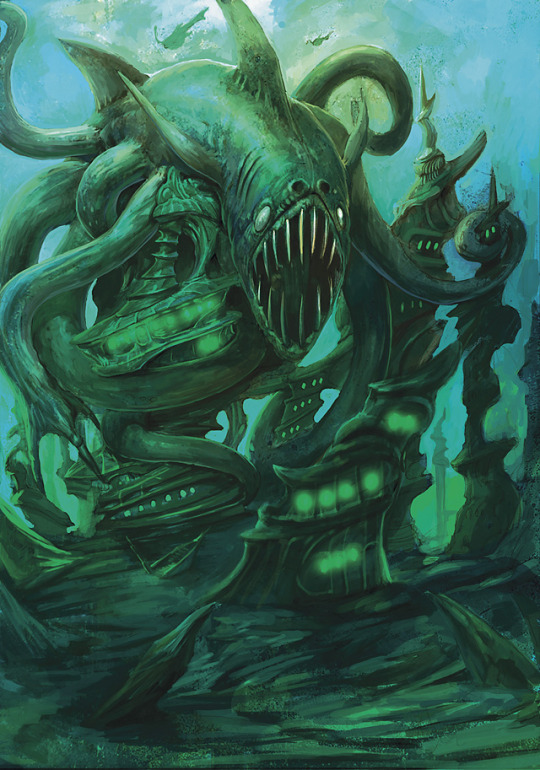
This is the form carved on blasphemous altars in the depths of the oceans, where sunlight has never reached. This is the form worshiped by mortals who delight in corruption, destruction, and fear, who dream of a sea where vision is a distant memory and predators hunt by the scent of blood. It is the form sought by those who lust for ancient lore, kept in places far from mortal sight and utilized by an evil older than many gods and mortal races, a form whose mere touch can taint a body of water, mutating & mutilating all within and unleashing their fury, their terror, their slaughter, for ages to come. And it is not Dagon. Dagon’s true form, imprisoned within that flesh, is I’m drowning in the cold dark, I can feel my bones breaking, my eyes are bursting, I’m blind and I’m drowning and I can’t die, my lungs are gone, the water is seeping into my blood I’m drowning and I just want to die make it stop I’m DROWNING.
It’s telling that witnessing Dagon’s true form, his Form of Madness, can give even creatures that breathe water, or which do not breathe at all, crippling hydrophobia.
The true forms of Obyriths are not flesh or matter; they are not, by nature, Material beings the way other Outsiders and mortal things are. Their true forms are that you, personally, are going mad. You, personally, are being assaulted, violated, and infected; you, personally, are being victimized, corrupted, consumed, and betrayed. Imagine if the act of pouring flesh-eating beetles into someone’s eyes had a personality, will, and desires - not the person doing it, the act itself - and that’s an Obyrith. They are evil because what they are is evil, much in the way Erythnul is evil. Unlike their creations, the Tanar’ri, Obyriths aren’t in it to kick every puppy that has ever existed. They want to throw off the yoke of the Law and release their unbound forms. They want an existence of darkness and isolation in which all beings are free to express their true essence to the limit of their might and their will.
They just wanna be themselves.
No matter who has to die.
The Foes Of All Reason - Using Obyriths In Your Campaign
Do you enjoy life’s little conveniences, such as cause-and-effect, linear time, predictable & observable physical laws, not having your body boil away beneath the agonizing will of some random asshole, and the capacity to recognize patterns in nature? Then Obyriths are your enemies. As demons, Obyriths can be summoned and are thus easy to use in the sort of ‘guest star’ role that Tanar’ri are often used in, even if it takes a moon-sized pair of brass balls to decide you can contain one. However, this use - while valid - is not a good way to bring out their cosmic horror themes, and since you decided to read an article about cosmic horror in D&D this far down I’m going to go ahead and assume you’d like to do that.
As one of the Planes’ most ancient and active evils - arguably the most ancient one that hasn’t died or otherwise fucked off - Obyriths are absolutely prime for campaigns that deal with ancient lore, primordial conflict, and unreality. If you like the idea of long-burn plots by masterminds with the patience of aeons, Obyriths are definitely for you. For an example of one such story, check out The Tale of the Whale, written by Afroakuma. The downside to using Obyriths in this way is that if you want to do so in canon settings, you need to be prepared to do some absolute fucking deep dives on the lore, which may require access to books or PDFs as far back as 1e & 2e. If you’re using your own setting this problem is lessened, though at that point you do have to manage to sell the ancient nature of such beings in a way that makes them feel suitably eldritch.
For more...let’s go ahead and say modern for lack of a better word, takes, keep in mind that Obyriths are not Tanar’ri. They do not scheme to overthrow the government of a nation; your pale, fleshly shadow of the Law is nothing to them. The plots of Obyriths upend the Laws which underpin reality itself. Could the great contract that details the alliance between the tribes of Men and Cats be found and perverted, turning each against the other in all reality? Could the insects of this realm be infected with the essence of Obox-Ob so that the Demon Prince of Vermin can feast on mortal souls and effect his own return to power? Could a bridge linking the Deep Ethereal to the Abyss be constructed, permitting the sibriexes and their master, the Prince of the Chrysalis, to shape new slaves from the very essence of raw Potential? Obyriths pervert what is and should be, not just because it suits their end goal of chaos unbound, but because corruption and violation is their very nature. It’s how they think, how they move, what they believe in, love, and value.
Obyriths have a lot to suggest for them when it comes to cosmic horror stories in D&D’s context. They bring out direct themes of madness, terrible truth, malign alien intelligence, and reality-unreality. You can comprehend their motives and even their nature, sort of, but their end goal is completely alien to mortal beings; the reality they want would be completely unrecognizable to the denizens of the current one. They are evil as mortals understand the concept, but not in a way that matches or even relates to their peers, which means they act in surprising and unpredictable ways.
All of this of course damages their ability to fulfill the classic cosmic horror thesis, but there’s something to be said about the idea that an alien intelligence, to be horrifying, needs something humans can attempt to relate to. It certainly makes writing for them easier.
If you’re using Obyriths in 3.5, you’re set to go; look for them in the various Monster Manuals, as well as Fiendish Codex. If you’re attempting to use them in Pathfinder, good decision but you’re gonna have some stat block converting to do. Trying to use them in 5e is gonna be the absolute bitch of a job, and I’m not sure where to even start on those suggestions except to note that the signature trait of Obyriths - the thing that makes them them, mechanically - is a Form of Madness ability, where they reveal their truth to their victims. Forms of Madness are mind-affecting abilities which hit all non-demons near the Obyrith, tainting them in some way. You can see some example ideas above, and the ones from 3.5 in the published books I just mentioned, but here’s hoping I can find an expert on 5th Edition’s mechanics kind enough to lend me a hand here.
I hope this article proved helpful to you! As with all of my work, questions and critique are welcome. Thanks for reading!
#D&D#planescape#far realms#demons#obyrith#cosmic horror#body horror#advice#I'm Not Sure How To Use Tags#reblogs welcome#critique welcome
63 notes
·
View notes
Text
Was thinking about getting into solo (or soloable) board games because sometimes I want to play a game but I don't want to play a video game you know?
Unfortunately most of the popular games I like (more narrative/roleplay heavy) are really expensive. Gloomhaven is highly recommended but I just checked on Amazon it's $120 CAD.
I was thinking about starting with Arkham Horror (the card game). The base game is cheap but people keep saying you really need the expansions.
Other games on my list currently:
Escape the Dark Castle
Friday (not what I'm looking for but it looks like a cute solo game)
Mansions of Madness 2e (I've heard really mixed opinions on this game, some swear by it solo and others are like buy one of the other mythos games)
Mythos Tales
Folklore: The Affliction (really interesting but pricey)
*shrugs*
1 note
·
View note
Text

Board game night with @erebabes to celebrate our anniversary! We’re gonna learn how to play Arkham Horror 2e first, wish us luck, this bitch got two rule books!
2 notes
·
View notes
Text
Re-Animator/Arkham Horror Custom Game Content: The Allies
Previously: the Investigators and the Monsters.
In Arkham Horror, Allies are a separate deck from items. They are mini-characters--often humans, sometimes animals--who can augment your investigator's stats, give you items, and so forth.
Here they all are; descriptions and notes below!

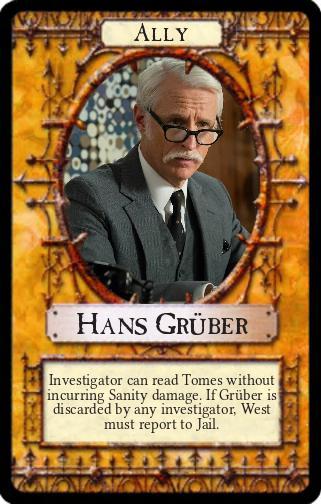
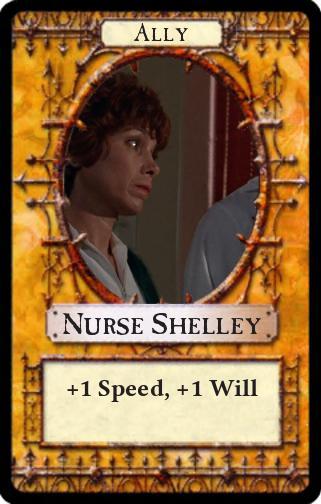


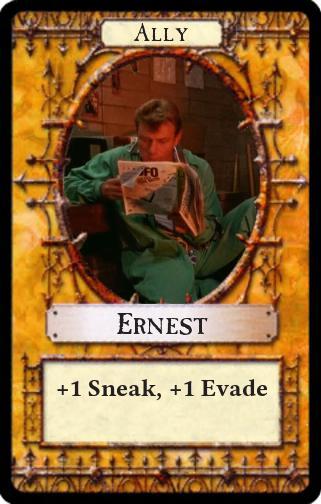
Gloria: +1 Lore, +1 Will. Return to the box if the Bride enters play.
Hans Grüber: Investigator can read Tomes without incurring Sanity damage. If Grüber is discarded by any investigator, West must report to Jail.
Nurse Shelley: +1 Speed, +1 Will
Rufus: [automatically is Meg's Ally] +1 Fight, +1 Luck. If discarded for any reason, add Dead Rufus to the monster cup.
Dr. Harrod: +1 Lore. Return to the box to prevent any investigator from being devoured, unless it is during the final battle.
Ernest: +1 Sneak, +1 Evade
"Discarding" and "returning to the box" mean different things in-game. A discarded card is returned to its deck; a card returned to the box is removed from play entirely. This is already disconcerting with important items being taken from you. It's worse with Allies, which are, after all, living beings.
The game has a "terror track" which shows the overall mood in Arkham. Every time the terror track is raised, you remove an Ally from the deck and return them to the box. This is supposed to imply that they're seeing how bad Arkham's getting and fleeing forever... but it's also possible to interpret it as the local eldritch cult sacrificing the Allies, if you're more cynical.
I generally view "discard" as meaning "in hiding" and "return to the box" as being "extremely dead".
Some of the wording on these cards will probably be tweaked before I do any printing, since Grüber and Rufus are definitely dead if they're discarded. That anybody can discard Grüber and get West sent to Jail is one of a couple of mechanics that allow for sniping/inter-investigator conflict. (Another is that you can control Dean Halsey and send him to attack another monster... or another investigator.)
Also, I couldn't find good shots of Grüber or Rufus, so their images did not come from either film.
Next up: new Items!
#re animator 1985#reanimator#bride of reanimator 1991#bride of re animator#crossover event#arkham horror#arkham horror 2e#custom investigator#tabletop games#board games#board game design
11 notes
·
View notes
Text
Re-Animator/Arkham Horror Custom Game Content: The Items
Previously: the Investigators, the Monsters, and the Allies.
Items in Arkham Horror are identified as Common or Unique. Common Items are usually mundane in and of themselves; Unique ones are frequently (but not always) magical or artifacts of some kind.
There's no way to replace the decks in their entirety; each one has at least 40 or 50 cards in it! These are meant to be shuffled into their respective decks. I guess you could shuffle them into the top halves of the decks to increase the likelihood of them being drawn and maintain the weird-ass Re-Animator flavor for the game.
Common Items
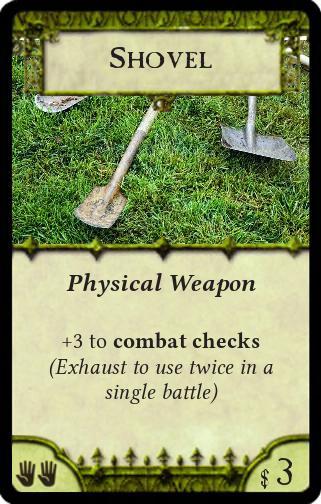
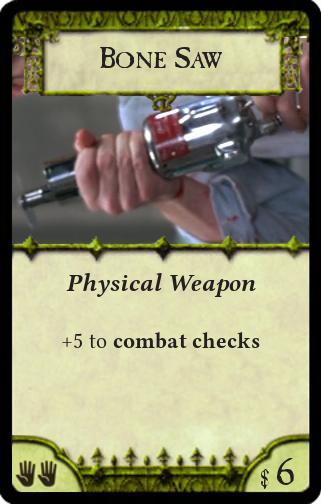

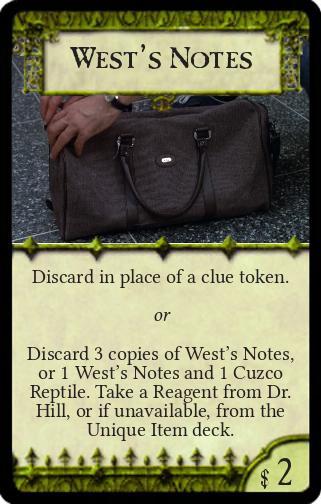
Shovel: Physical Weapon. +3 to combat checks. Exhaust to use twice in a single battle. Two-handed weapon, costs $3.
Bone Saw: Physical Weapon. +5 to combat checks. Two-handed weapon, costs $6.
Stolen Pistol: Physical Weapon. +4 to a combat check. (If held by an investigator while in the Police Station or in an encounter with the police, they must report to Jail). One-handed weapon, costs $3.
West's Notes [3 copies in total]: Discard in place of a clue token. or Discard 3 copies of West's Notes, or 1 West's Notes and 1 Cuzco Reptile. Take a Reagent from Dr. Hill, or if unavailable, from the Unique Item deck.
Unique Items

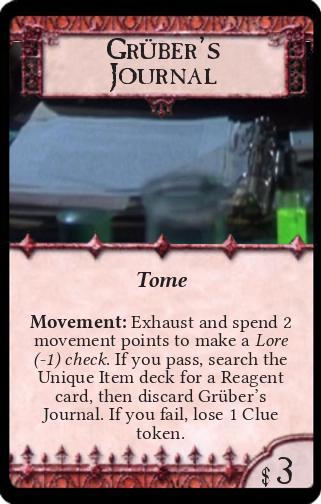
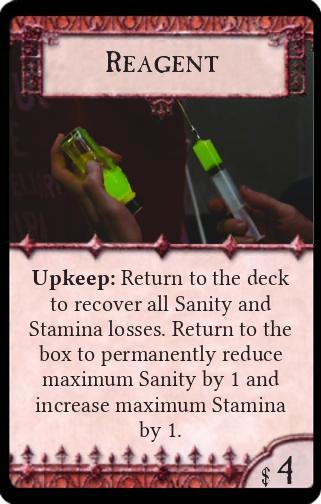
Cuzco Reptile [3 copies total]: +1 to Evade checks. Discard along with 1 West's Notes to take 1 Reagent from Dr. Hill. If unavailable, take 1 Reagent from the Unique Item deck. Cost $5.
Grüber's Journal: Tome. Movement: Exhaust and spend 2 movement points to make a Lore (-1) check. If you pass, search the Unique Item deck for a Reagent card, then discard Grüber's Journal. If you fail, lose 1 Clue token. Costs $3.
Reagent [6 copies total]: Upkeep: Return to the deck to recover all Sanity and Stamina losses. Return to the box to permanently reduce maximum sanity by 1 and increase maximum Stamina by 1. Costs $4.
So, yes--a big part of the game involves finding ways of making Reagent and using it to your advantage. And yes, a big part of that process puts you in conflict with Dr. Hill (specifically, his head) who is the Ancient One.
Speaking of, Drs. Graves and Hill will be in the final post tomorrow!
#re animator#reanimator 1985#bride of reanimator 1991#bride of re animator#arkham horror 2e#arkham horror#board game design#board games#tabletop games#crossover event#custom investigator#custom content
13 notes
·
View notes
Text
Re-Animator/Arkham Horror Custom Game Content: The Ancient One
Previously: the Investigators, the Monsters, the Allies, and the Items.
In Arkham Horror, you're fighting a big baddie, generally ID'ed as an Ancient One (or Great Old One... or GOO, if you're feeling cute). The GOO receives its own turn and has limited, randomized control over the environment, monster movement and behavior, and investigator abilities. They can control the very weather, causing hailstorms one day and firestorms the next; inflict plagues, create eclipses that last for days... and so it goes.
Naturally, the only character deserving of Ancient One status is our resident creepazoid and necromancer, Dr. Hill.
(Have I mentioned that you can make cards like this too? Strange Eons is free to download and use to make your own custom content for Arkham Horror! You do have to collect your own screencaps/art and write your own stats, but there are guides out there for doing so... and Strange Eons comes with base characters/objects/abilities you can study to learn how to do it yourself.)
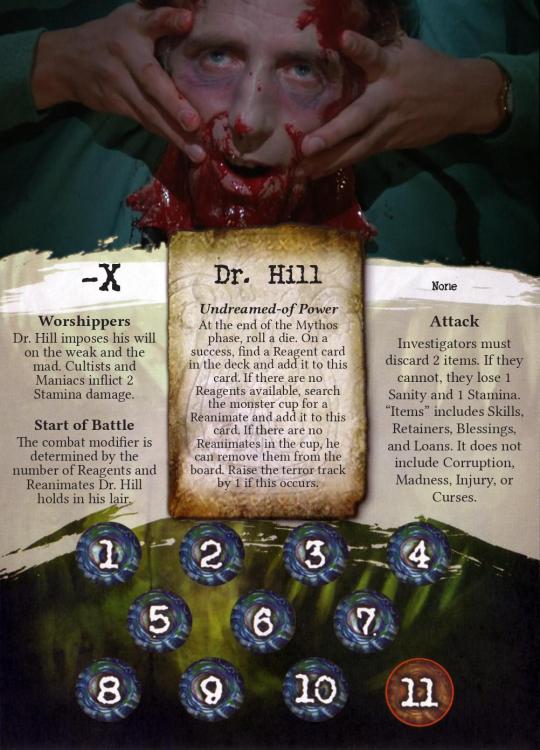
Combat Modifier: -X
Resistances or Immunities: None
Worshippers: Dr. Hill imposes his will on the weak and the mad. Cultists and Maniacs inflict 2 Stamina damage.
Ongoing Game Effect: Undreamed-of Power. At the end of the Mythos phase, roll a die. On a success, find a Reagent card in the deck and add it to this card. If there are no Reagents available, search the monster cup for a Reanimate and add it to this card. If there are no Reanimates in the cup, he can remove them from the board. Raise the terror track by 1 if this occurs.
Start of Battle: The combat modifier is determined by the number of Reagents and Reanimates Dr. Hill holds in his lair.
Attack: Investigators must discard 2 items. If they cannot, they lose 1 Sanity and 1 Stamina. "Items" includes Skills, Retainers, Blessings, and Loans. It does not include Corruption, Madness, Injury, or Curses.
Doom track: 11
To explain this card, I will have to get into some detail about game mechanics, so let's get autistic in here
Cultists and Maniacs are weaker monsters who are typically boosted by the GOO. Here, I'm trying to channel the energy of Hill augmenting and focusing his creatures. If I get around to a Dr. Graves card, he may also be able to boost Reanimates and Zombies, which would be just fucking awful to handle
His theoretical combat modifier, if he collected all Reagents and Reanimates, could be -18. To do combat in this game, you roll dice equivalent to your Fight and all your weapons/spells, and tally up your "successes". Negative combat modifiers take dice away from you. A -18 modifier makes him unbeatable. Hell, a -10 would probably make him unbeatable. But if you can keep the Reagent out of his hands (or steal it from him), he could have a combat modifier of 0... much easier to cope with
Discarding items allows for stuff that's not traditionally considered to be items, but can be very beneficial... but nothing that's not beneficial. This is supposed to recall Hill's unfortunate habit of stripping everything he can from his enemies, whether that's literal in certain cases, or metaphorical, as when he tries to lobotomize Herbert.
That doom track. The doom track gives you an idea of how long the game can run for. 13-14 spaces gives you a long-ass slog, and is associated with the most powerful GOOs in the game (they take a while to wind up, but that pitch). 10 or 11 lends itself to a much quicker game, and tends to be associated with weaker, less mystical/universe-ending GOOs. Hill has a short doom track to reflect that he probably can destroy Arkham, but not necessarily the world... but he can do it fast if you're not careful.
Is there more game content? Not yet! I never got around to making Graves, lol. Nor have I written those Personal Stories for each Investigator yet, but I will post them when they're available.
What @andalusiapunk and I did do the other night was playtest with the investigators. Just the characters, none of the items. So probably before I get to more custom content, I will do a writeup on Herbert, Dan, Meg, and Francesca locked in mortal combat with Nyarlhathotep.
That game involved Dan being unable to read and joining a cult, Dan romancing Herbert by giving him body parts, Meg and Herbert teaming up as they were always meant to do, and Francesca losing her job because she bought food from a stranger out of the classifieds. A giant worm almost drilled its way through the entirety of Arkham. We drew WAY more zombies than we normally do in a game and a lot of action coincidentally took place in or near the graveyard.
And Herbert finally got to use the Milk of Shub-Niggurath. That was fun and by fun I mean fuckbonkers.
#reanimator#re animator 1985#reanimator 1985#bride of reanimator#bride#bride of re animator#bride of reanimator 1991#arkham horror#arkham horror 2e#tabletop games#board games#board game design#custom content#crossover event#custom investigator#blood
5 notes
·
View notes
Text
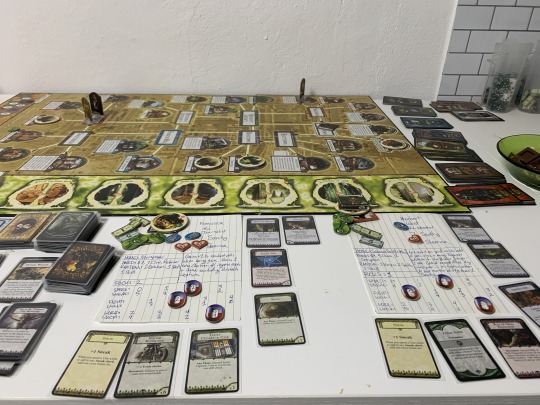
Back at it again
2 notes
·
View notes
Text
Re-Animator/Arkham Horror Custom Game Content: The Monsters
Loooootta gore here, but that's nothing new for this fandom amirite?
Previously: the Investigators.
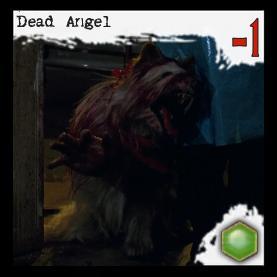

Dead Angel's stats
Evade modifier: -1
Movement on: Hexagon cards (the Abyss)
Movement type: Normal
Qualities: Undead, Physical Resistance
Horror check modifier: -3
Horror damage: 2 Sanity
Combat check modifier: -1
Combat damage: 2 Stamina
Toughness: 2
Special: Dead Angel is Nightmarish to Francesca, who receives 1 Sanity damage.


Dead Rufus's stats
Evade modifier: -2
Movement on: Hexagon cards (the Abyss)
Movement type: Normal
Qualities: Undead, Ambush
Horror check modifier: -2
Horror damage: 1 Sanity
Combat check modifier: -2
Combat damage: 1 Stamina
Toughness: 1
Quote: "Do you agree that it's dead now?"
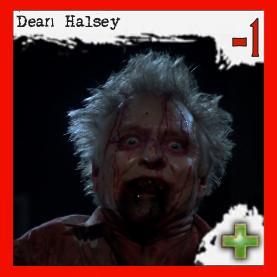
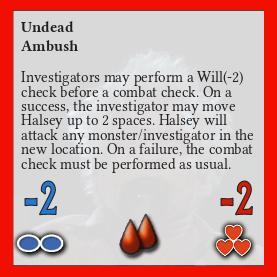
Dean Halsey's stats
Evade modifier: -1
Movement on: Plus cards (R'lyeh)
Movement type: Fast
Qualities: Undead, Ambush
Horror check modifier: -2
Horror damage: 2 Sanity
Combat check modifier: -2
Combat damage: 3 Stamina
Toughness: 2
Special: Investigators may perform a Will (-2) check before a combat check. On a success, the investigator may move Halsey up to 2 spaces. Halsey will attack any monster/investigator in the new location. On a failure, the combat check must be performed as usual.
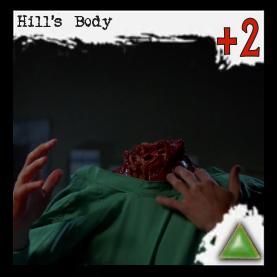

Hill's Body stats
Evade modifier: +2
Movement on: Triangle cards (City of the Great Race)
Movement type: Normal
Qualities: Undead, Physical Resistance
Horror check modifier: -2
Horror damage: 1 Sanity
Combat check modifier: None
Combat damage: 3 Stamina
Toughness: 3
Special: Instead of performing a combat check, investigators may discard 1 Reagent card. Hill's Body is moved to the box [removed from the game permanently]. Two doom tokens are removed from the track. Each investigator loses 1 Sanity and 1 Stamina.
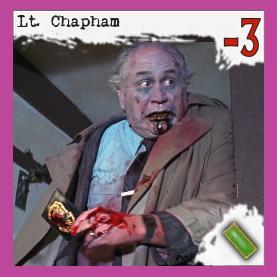
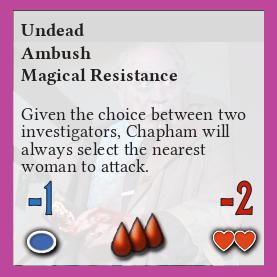
Lieutenant Chapham
Evade modifier: -3
Movement on: Slash cards (The Dreamlands)
Movement type: Stalker [moves directly towards the nearest investigator instead of following normal movement rules]
Qualities: Undead, Ambush, Magical Resistance
Horror check modifier: -1
Horror damage: 1 Sanity
Combat check modifier: -2
Combat damage: 2 Stamina
Toughness: 3
Special: Given the choice between two investigators, Chapham will always select the nearest woman to attack.

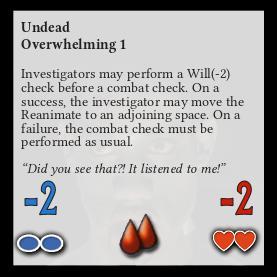
Morgue Reanimate's stats [note that there are 5 total per game]
Evade modifier: +1
Movement on: Hexagon cards (the Abyss)
Movement type: Normal
Qualities: Undead, Overwhelming (1 automatic Stamina damage)
Horror check modifier: -2
Horror damage: 2 Sanity
Combat check modifier: -2
Combat damage: 2 Stamina
Toughness: 2
Special: Investigators may perform a Will (-2) check before a combat check. On a success, the investigator may move the Reanimate to an adjoining space. On a failure, the combat check must be performed as usual.
Quote: "Did you see that?! It listened to me!"

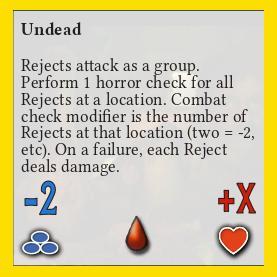
Reanimate Reject's stats [note that there are 5 total per game]
Evade modifier: +1
Movement on: Star cards (Great Hall of Celeano)
Movement type: Stationary
Qualities: Undead
Horror check modifier: -2
Horror damage: 3 Sanity
Combat check modifier: +X
Combat damage: 1 Stamina
Toughness: 1
Special: Rejects attack as a group. Perform 1 horror check for all Rejects at a location. Combat check modifier is the number of Rejects at that location (two = -2, etc). On a failure, each Reject deals damage.
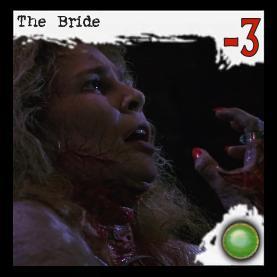
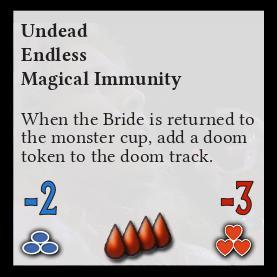
The Bride's stats
Evade modifier: -3
Movement on: Circle cards (Yuggoth)
Movement type: Normal
Qualities: Undead, Endless [cannot be taken as a trophy], Magical Immunity
Horror check modifier: -2
Horror damage: 3 Sanity
Combat check modifier: -3
Combat damage: 3 Stamina
Toughness: 4
Special: When the Bride is returned to the monster cup [after defeat in combat], add a doom token to the doom track.
Next up: the Allies!
#re animator#reanimator 1985#bride of reanimator 1991#bride of re animator#crossover event#arkham horror#arkham horror 2e#bride of reanimator#custom investigator#tabletop games#board games#board game design#blood#gore
1 note
·
View note
Text
Hello, I have been away for four days because I've been using a 15-year-old computer program (Strange Eons) to build an entire gameset for a 19-year-old board game (Arkham Horror 2e) utilizing characters from a 36-year-old movie and its sequel (Re-Animator and Bride), all things that are perfectly normal.
Okay, that's not all I did.
I also playtested them with my partner-in-crime and found that Herbert West stopped Cthulhu from waking up while losing almost all his Sanity in the process.
I'm putting this in the "just got lucky, needs more playtesting" category rather than the "I massively OPed this character" category but it makes a really funny paragraph.
These are their markers. The white space at the top is there because Arkham Horror markers are shaped like gravestones. Cheerful!
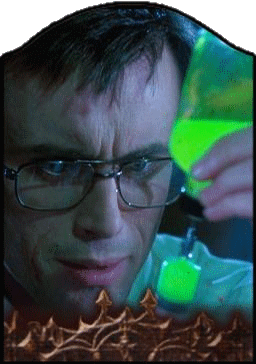



#reanimator#re animator#reanimator 1985#dan cain#herbert west#megan halsey#arkham horror#board games#cthulhu#bride of reanimator#bride of reanimator 1991#bride of re animator#i've made monsters and an Ancient One card for dr. hill and reagent cards#i'm working on personal stories for the investigators#if anybody's interested then i'll post my work on here#and if you're not interested you'll probably get it anyway
30 notes
·
View notes